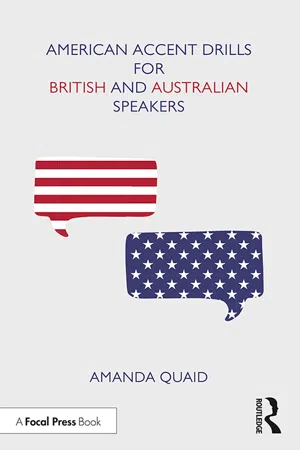
American Accent Drills for British and Australian Speakers
Amanda Quaid
- 94 páginas
- English
- ePUB (apto para móviles)
- Disponible en iOS y Android
American Accent Drills for British and Australian Speakers
Amanda Quaid
Información del libro
American Accent Drills for British and Australian Speakers provides a comprehensive guide to learning a "General American" accent, made specifically for native English speakers.
Unlike most American accent guides, which are geared toward ESL learners, this handbook covers only the shifts that English speakers need to make – nothing more, nothing less. In addition to vowel and consonant drills, it covers the finer points of American intonation and elision, features that often elude English speakers of other dialects. Finally, it provides exercises for "owning" the dialect, finding authenticity and making it work for each individual actor in their own way.
This is an excellent resource for students of speech and dialects, actors from the UK, Australia, and New Zealand, and advanced ESL learners who need to use an American accent on screen or on stage.
American Accent Drills for British and Australian Speakers also includes access to downloadable audio files of the practice drills featured in the book, to help students practice and perfect their American accent.
Preguntas frecuentes
Información
1
Vowels and Diphthongs
Articulators
Immovable Articulators
Moveable Articulators

[æ] as in Trap and Bath
Structure
Words
- apple cap gap lap map nap perhaps tap cab crab fabulous bat cat fat rat sat Saturday bad dad glad mad sad sadly back Jack lack pack quack rack sack vacuum bag tag flag gag Africa traffic avenue average lavender savage Al pal athlete Katherine math fascinate passenger gas ash cash crash dash mash rash trash badge imagine pack lack lad gladly status
- after bath path ask disaster grass pass class fast cast last giraffe master laugh basket blasted craft nasty mask pasture pass raspberry half
- (note: these might sound a bit more nasal—see the upcoming Special Topic) advantage answer can’t chance dance enhance France plant example reprimand command grant
- (note: the stress falls on the second syllable) caffeine café
Phrases
- sad, glad or mad?
- trash bag
- fascinating class
- relaxing bath
- Katherine’s passions
- vacuum bag
- fat cat
- Jack’s values
- pass the basket
- bad traffic
- Madison Avenue
- last laugh
Sentences
- The actress gave a class on craft.
- Jack chatted out back with Katherine.
- The giraffes in Africa were commanding.
- I’m asking Alice to answer, not Al.
- Their nasty laughter made dad sad.
- Matt had a relaxing bath on Saturday.
Special Topic: [æ] + [n], [m], [ŋ]
| [ɛ̃ən] | [ɛ̃əm] | [ẽıŋ] |
|---|---|---|
| can’t | camera | canker |
| ban | bam | bank |
| Anna | amber | angle |
| Dan | damp | dangle |
| fan | family | fang |
| began | gamma | gang |
| can | camp | kangaroo |
| pan | Pamela | pancreatic |
| hand | ham | hang |
| January | jam | jangle |
| land | lamb | Lang |
| ran | Rambo | rang |
| channel | champion | Chang |
| tan | tambourine | tank |
| mannequin | mammogram | mango |
| piano | ammo | anxiety |